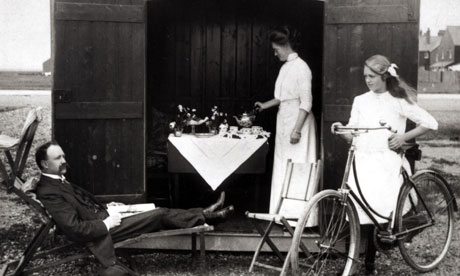
As the last sets of the Encyclopedia Britannica prepare to sink into obscurity, there's one edition that will always remain a collector's item: the 11th.
Published between 1910 and 1911, the 11th edition continues to inspire a religious reverence from its loyal adherents. The siren call of its 28 leather-bound volumes works a subtle magic on antiquarians, historians, booksellers, and scholars around the world.
So, why the appeal? AJ Jacobs, an American journalist, read his way through the entirety of the 15th edition of the Encyclopedia Britannica published in 2002. He wrote about his experience in the well-received book The Know-It-All: One Man's Humble Quest to Become the Smartest Person in the World. I spoke with Jacobs about the lasting appeal of the 11th. He said that "compared to more modern editions, reading the 11th is like reading a Faulkner novel instead of an instruction manual."
The 11th is exceptionally well written, the first encyclopedia where readability was courted in addition to scholarship. But its durability goes deeper than that.
Jacobs continued, "I think Hans Koning of the New Yorker nailed the appeal 30 years ago. He said it was the last great work of the age of reason, the final instance when all human knowledge could be presented with a single point of view. Four years later, the confidence and optimism that had produced the 11th would be, as he puts it, 'a casualty in the slaughter at Ypres and the Argonne.'"
And he's right. To open an 11th edition of the Encyclopedia Britannica is to open a worldview lost forever in the staggering slaughter of the first world war. The 11th edition of the Britannica represents the high tide of optimism and belief in human progress that had dominated the Anglo-Saxon vision since the Enlightenment.
Unabashed optimism – and unabashed racism – pervades many entries in the 11th, and provide its defining characteristics. The Edwardian world was finely ordered in the way an encyclopedia needs the world to be finely ordered: everything, and everyone, in their place. Interpreted for you by the rich, the white, and the expensively educated.
The entry on antisemitism states that it is "a passing phase in the history of culture". This was written 30 years before the horrors of Nazi Germany. The Vietnamese are the "worst-built and ugliest of all the Indo-Chinese," while the Chinese are "inferior in character" to Europeans. Arabs are noted for a propensity to be "cruel" and "crafty," and Africans "appear to stand on a lower evolutionary plane than the white man".
Despite its occasional ugliness, the reputation of the 11th persists today because of the staggering depth of knowledge contained with its volumes. It is especially strong in its biographical entries. These delve deeply into the history of men and women prominent in their eras who have since been largely forgotten – except by the historians, scholars, and antiquarian booksellers who champion the 11th for this quality.
It's among antiquarian booksellers that the 11th enjoys its highest reputation. Norman Kane, an American rare book dealer of over 50 years experience, only recently parted ways with his 11th, and that decision was a reluctant result of a cross-country move. "The [index] is full of names that resonate in all fields of the arts and sciences. People whose books we sell every day. More recent editions have lost, I believe, much of the antiquarian flavour that recommends it to us. We are after all more interested in the out-of-date than in the up-to-date."
Among those resonating names are TH Huxley, Alfred North Whitehead, Algernon Swinburne and Peter Kropotkin. Fifteen hundred men and an impressive (by Edwardian standards) 200 women contributed articles to the 11th edition, which was edited by Hugh Chisholm. Under his editorship, the Britannica combined scholarship and readability in a way no previous encyclopedia ever had – and, arguably, no encyclopedia has been able to repeat. Chisholm also revolutionised encyclopedia publishing by releasing the first 14 volumes in the autumn of 1910 and the second 14 volumes, along with an index, in the spring of 1911. The volumes in previous editions were released as they were completed, with years passing between publication of the first and final volumes. Under the new model, the entire Britannica was assembled before crucial articles went out of date.
With the publication of the final volumes of the 11th, in the spring of 1911, came the last stand of the Enlightenment. One year later the Titanic would strike an iceberg. Three years later, Franz Ferdinand was assassinated. Five years later, a staggering 1.25m people would die in the Battle of the Somme. And the world would never be the same.
When viewed in that light, the worn leather volumes of the 11th acquire an almost mythic quality. Its pages contain all the knowledge of a world on the brink of deep and everlasting change. And that is why the 11th edition of the Encyclopedia Britannica will outlast all the others.

